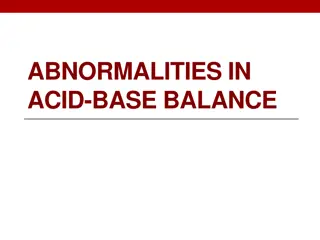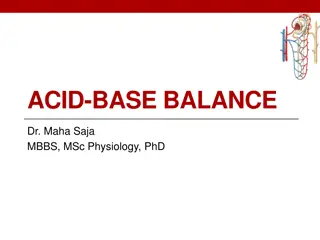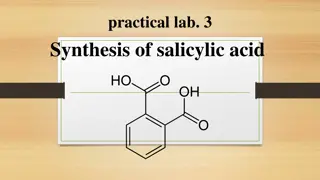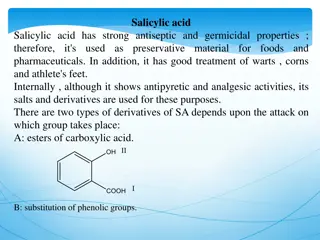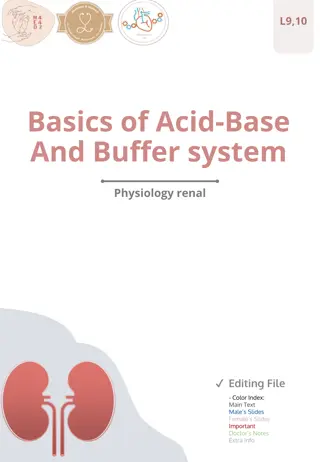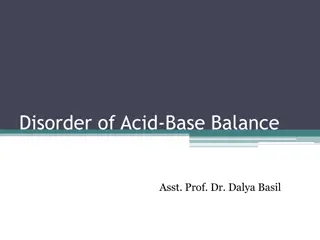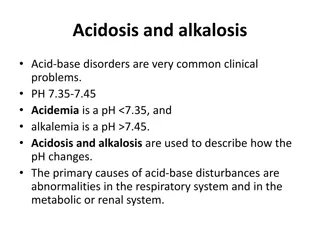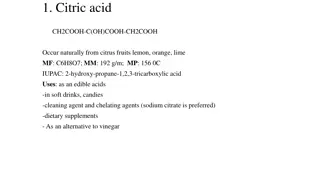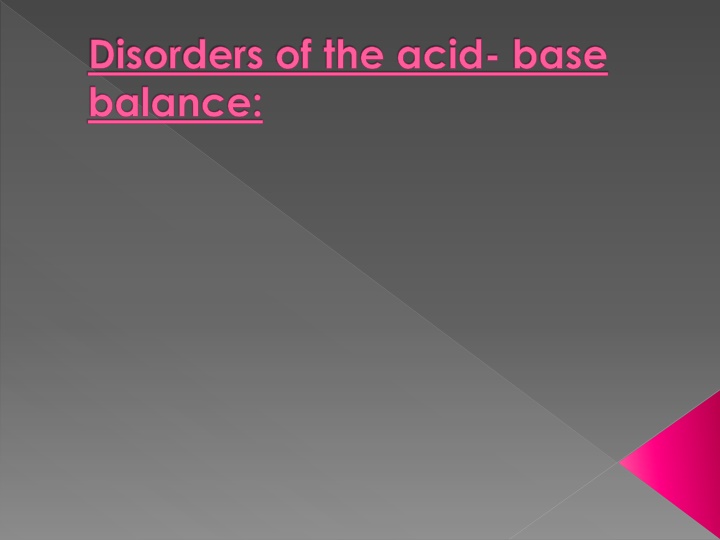
Acid-Base Balance Disorders
Learn about the regulation of body acids and bases, the types of acids present, production of metabolic acids, buffering systems in the body, and mechanisms for maintaining acid-base balance. Explore the crucial role of the lungs and kidneys in eliminating acids and maintaining pH levels within a narrow range.
Download Presentation

Please find below an Image/Link to download the presentation.
The content on the website is provided AS IS for your information and personal use only. It may not be sold, licensed, or shared on other websites without obtaining consent from the author. If you encounter any issues during the download, it is possible that the publisher has removed the file from their server.
You are allowed to download the files provided on this website for personal or commercial use, subject to the condition that they are used lawfully. All files are the property of their respective owners.
The content on the website is provided AS IS for your information and personal use only. It may not be sold, licensed, or shared on other websites without obtaining consent from the author.
E N D
Presentation Transcript
Disorders of the acid- base balance:
Normally, the concentration of the body acids and bases is regulated so that the pH of ECF is maintained within the very narrow range of (7.35-7.45). The balance is maintained mechanisms that generate buffer and eliminate acids and bases. Acids in the body are either: 1- volatile 2- non-volatile. through
Volatile: carbonic acids Carbonic acids is in equilibrium with CO2 which is volatile and leaves the body by way of the lungs. Therefore, the carbonic acid level is determined by the lungs and their capacity to exhale carbon dioxide. Non- volatile (fixed): like sulfuric, hydrochloric and phosphoric acids. Not maintained by the lungs, instead they are buffered by body proteins or extracellular buffers as HCO3 and then eliminated by the kidney.
Production of metabolic acids: 1. Sulfuric acid: results from oxidation of sulfur containing amino acids e.g., (methionine, cysteine) 2. Hydrochloric acid: results from oxidation of arginin and lysine 3. Phosphoric acid: results from oxidation of phosphorous containing amino acids. 4. Lactic acid: results from the incomplete oxidation of glucose. 5. Ketoacids: results oxidation of fats. from the incomplete
Buffering systems in the body: The three major buffer systems that protect the pH of body fluids are: 1. Bicarbonate buffer system 2. Transcellular hydrogen- potassium exchange system 3. Body proteins. Bone provides an additional buffering of body acids. CO2 is the end product of aerobic metabolism, 10% of it is transported in dissolved state to the lungs and then exhaled. Rest CO2 moves into RBCs and form carbonic acids.
HCO3 is exchanged for Cl ions and moves out to plasma. HCO3 & CO2 accounts for 77% of CO2 transported in ECF. Rest transported carbaminohemoglobin. as
Mechanisms of regulating acid- base balance: 1- Renal mechanisms balance cannot adjust pH as respiratory provide: A- Elimination of H in the urine. B- Absorption of filtered HCO3. C- Production of new bicarbonate. 2- Respiratory control mechanisms A- Elimination of CO2 B- Occurs within minutes. control mechanism: regulating the renal base for acid- within minutes can; mechanism they
Disorders of acid- base balance are either metabolic or respiratory. Metabolic disorders alteration in HCO3 concentration. And result from the addition or loss of non volatile acid or alkali to or from the ECF. produce an
Metabolic acidosis: It involves a primary deficit in base HCO3 along with a decrease in plasma pH. Causes: The deficit in HCO3 is either by loss of HCO3 or excess of non-volatile acids. Metabolic acidosis can be caused by one of the four mechanisms:
1- Increased production of metabolic acids: accumulation of lactic production of ketoacids. Lactic acids is produced by the anaerobic metabolism of glucose. Most cases of lactic acidosis are caused oxygen delivery as in shock or cardiac arrest Ketoacids: produced in the liver from fatty acids, are the source of fuel for many body tissues. An overproduction of ketoacids occurs when carbohydrate stores are inadequate or when the body cannot carbohydrates as a fuel. acid and excess by the inadequate use available
2- Decreased renal function (renal failure): the most common cause of chronic metabolic acidosis is the chronic kidney disease, in this case there is loss of glomerular and tubular function, with retention of nitrogen and wastes and metabolic acids. 3- Increased bicarbonate losses: Increased HCO3 losses occur with the loss of bicarbonate rich body fluids. Intestinal secretions have a high HCO3 concentration, consequently, excessive losses of HCO3 ions occur with severe diarrhea. Note: vomiting cause chloride loss Diarrhea: cause bicarbonate loss.
4- Hyperchloremic serum chloride increases, because chloride and bicarbonate are exchangeable anions the serum HCO3 decreases when there is an increase in Cl. Hyperchloremic acidosis can occur as a result of abnormal absorption of Cl by the kidneys or as a result of treatment with chloride containing medications such as sodium chloride, ammonium chloride .. acidosis: occurs when
Manifestations: 1- Blood pH decreased. HCO3 serum level decreased PCO2 (compensatory) decreased. 2- Gastrointestinal function. Anorexia, nausea, vomiting and abdominal pain. 3- Neural function Weakness, lethargy, general malaise, confusions, coma and depression of vital functions. 4- Cardiovascular vasodilatation , cardiac dysarrythemia. 5- Skin; warm and flushed. function: peripheral
Metabolic alkalosis: It is a systemic disorder caused by an increase in pH due to a primary excess of plasma HCO3 ions. Causes: 1- Excess alkali intake: excessive alkali ingestion, as in the use of bicarbonate containing antiacids.
2- Bicarbonate removal of gastric secretions through the use of nasogastric potassium levels resulting from diuretic therapy. In hypokalemia, K moves out of the tubular cell into replaced by the H ion, this results in intracellular acidosis HCO3 reabsorption. retention: vomiting, suction and low the blood and is and increased
Manifestations of metabolic alkalosis: 1- Blood pH increased Serum HCO3 increased. PCO2 (compensatory) increased. 2- Neural function: Confusion, hyperactive reflexes, tetany and convulsions 3- Cardiovascular functions: dysarrythemia. 4- Respiratory function: respiratory acidosis due to decreased respiratory rate. Signs of compensation: decreased rate and depth of respiration 5- Increased urine PH. hypotension and
Respiratory acidosis: 1- Involves an increase in PCO2 and H2CO3 along with a decrease in pH. Acute respiratory failure is associated with a rapid rise in arterial PCO2 with a minimal increase in HCO3 and large decrease in pH. 2- Within a day or so, renal compensatory mechanisms begin generate HCO3. to conserve and
Causes: 1- Acute respiratory acidosis can be caused by impaired function of the respiratory centre in the medulla ( as in narcotic overdose), lung disease, chest injury, weakness of the respiratory muscles, or airway obstruction. In many cases, signs of hypoxemia develop before those of because CO2 diffuses across the alveolar capillary membrane 20 times more rapidly than oxygen disorders of ventilation: acute respiratory acidosis
2- Chronic disorders of ventilation: chronic respiratory acidosis is a relatively common disturbance in patients obstructive lung disease. In these persons, the persistent elevation of PCO2 stimulates renal H ion secretion reabsorption. The effectiveness of these compensatory mechanisms return the pH to near- normal values. Chronic lung disease as chronic bronchitis and emphysema. with chronic and HCO3 can often
3- Increased carbon dioxide production: it can be caused by numerous processes including exercise, fever and burn; also a CHO rich diet produces large amounts of CO2.
Manifestation of respiratory acidosis: Blood pH decreases, PCO2 (primary) increased, HCO3 (compensatory) increased. Neural function: diltation of cerebral vessels and depression of neural function, headache, weakness, confusion, depression, tremors, paralysis , stupor and coma. Skin warm and flushed, signs of compensation ; aciduria.
Respiratory alkalosis: Involves a decrease in PCO2 primary deficit in H2CO3 along with an increase in pH, also hypocapnia. and a referred to as
Causes: Respiratory hyperventilation or a respiratory rate in excess of that needed to maintain normal plasma PCO2. It may occur as the result of central stimulation respiratory centre peripheral ( e.g., carotid chemoreceptor) pathways to the centre. Mechanical produce respiratory alkalosis if the rate and tidal volume are set so that CO2 elimination exceeds CO2 production. alkalosis is caused by of or the stimulation medullary of medullary ventilation respiratory may
Central respiratory centre occurs with anxiety, pain, pregnancy, febrile states, sepsis, encephalitis and salicylate toxicity. stimulation of the medullary Hypoxemia peripheral chemoreceptors which leads to hyperventilation alkalosis. leads to stimulation of and respiratory
Manifestations: 1- Blood pH increased, PCO2 (primary) decreased, HCO3(compensatory) decreased. 2- Neural function; constriction of cerebral vessels and increased excitability, dizziness. headache and tetany. Numbness and tingling of fingers and toes. 3- Cardiovascular dysarrythemia. neuronal Panic, light function; cardiac


